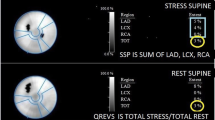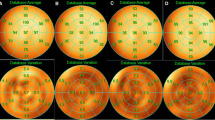Abstract
Purpose
Coronary artery disease remains one of the most significant causes of morbidity and mortality among women. The published literature shows the importance of standard single photon emission computed tomography in the evaluation of women with known or suspected ischaemic heart disease, in terms of target intervention and clinical treatment. The purpose of the present study was to ascertain the diagnostic accuracy of cadmium-zinc-telluride (CZT) myocardial perfusion imaging according to gender, within a prospective database of patients with known or suspected coronary artery disease, using coronary angiography as the reference standard.
Methods
Included in the study were 309 consecutive patients, of whom 248 were men (80 %), with known or suspected coronary artery disease and who had been referred to our laboratory for stress–rest myocardial perfusion imaging. All patients underwent coronary angiography within 30 days. All patients underwent a single-day stress–rest low-dose ultrafast protocol. Fifteen minutes after the end of the stress (dose range 185 to 222 MBq of 99mTc-tetrofosmin), all patients underwent the first scan with an acquisition time of 7 min. The rest scan (dose range 370 to 444 MBq of 99mTc-tetrofosmin) was acquired from 30 min to 45 min after injection, with an acquisition time of 6 min. Images were visually inspected, and summed stress scores (SSS) and summed rest scores (SRS) were obtained.
Results
Image quality was graded “good” or better in more than 90 % of patients. On coronary angiography, left main trunk stenosis, left anterior descending artery stenosis, left circumflex artery stenosis and right coronary artery stenosis were seen in 3, 155 , 142 and 131 patients, respectively. In women, the mean SSS and SRS were 8 ± 5 and 3 ± 1, respectively. Semiquantitative regional and global SSS were good discriminants of coronary artery disease, and the overall area under the receiver operator characteristic (ROC) curve was 0.822 (95 % CI 0.685 – 0.959). The value was comparable to that obtained in men (overall ROC area 0.884, 95 % CI 0.836 – 0.933).
Conclusion
A low-dose protocol with a CZT camera can be routinely used in women with known or suspected coronary artery disease without loss of accuracy and with lower radiation exposure of the patients.


Similar content being viewed by others
References
Rosamond W, Flegal K, Friday G, Furie K, Go A, Greenlund K, et al. Heart disease and stroke statistics—2007 update: a report from the American Heart Association Statistics Committee and Stroke Statistics Subcommittee. Circulation. 2007;115:e69–e171.
Mosca L, Banka CL, Benjamin EJ. Evidence-based guidelines for cardiovascular disease prevention in women: 2007 update. Circulation. 2007;115:1481–501.
Holdright DR, Fox KM. Characterization and identification of women with angina pectoris. Eur Heart J. 1996;17:510–7.
Kwok Y, Kim C, Grady D, Segal M, Redberg R. Meta-analysis of exercise testing to detect coronary artery disease in women. Am J Cardiol. 1999;83:660–6.
Santana-Boado C, Candell-Riera J, Castell-Conesa J, Aguadé-Bruix S, García-Burillo A, Canela T, et al. Diagnostic accuracy of technetium-99m-MIBI myocardial SPECT in women and men. J Nucl Med. 1998;39:751–5.
Hachamovitch R, Berman DS, Kiat H, Bairey CN, Cohen I, Cabico A, et al. Effective risk stratification using exercise myocardial perfusion SPECT in women: gender-related differences in prognostic nuclear testing. J Am Coll Cardiol. 1996;28:34–44.
Marwick T, Shaw L, Lauer M, Kesler K, Hachamovitch R, Heller G, et al. The noninvasive prediction of cardiac mortality in men and women with known or suspected coronary artery disease: Economics of Noninvasive Diagnosis (END) Study Group. Am J Med. 1999;106:172–8.
Shaw LJ, Heller GV, Travin MI, Lauer M, Marwick T, Hachamovitch R, et al. Cost analysis of diagnostic testing for coronary disease in women with stable chest pain. J Nucl Cardiol. 1999;6:559–69.
Mieres JH, Shaw LJ, Arai A, Budoff MJ, Flamm SD, Hundley WG, et al. Role of noninvasive testing in the clinical evaluation of women with suspected coronary artery disease: consensus statement from the Cardiac Imaging Committee, Council on Clinical Cardiology, and the Cardiovascular Imaging and Intervention Committee, Council on Cardiovascular Radiology and Intervention, American Heart Association. Circulation. 2005;111:682–96.
Gimelli A, Bottai M, Genovesi D, Giorgetti A, Di Martino F, Marzullo P. High diagnostic accuracy of low-dose gated-SPECT with solid-state ultrafast detectors: preliminary clinical results. Eur J Nucl Med Mol Imaging. 2012;39:83–90.
Gimelli A, Bottai M, Giorgetti A, Genovesi D, Filidei E, Marzullo P. Evaluation of ischemia in obese patients: feasibility and accuracy of a low-dose protocol with a cadmium-zinc telluride camera. Eur J Nucl Med Mol Imaging. 2012;39:1254–61.
Herzog BA, Buechel RR, Katz R, Brueckner M, Husmann L, Burger IA, et al. Nuclear myocardial perfusion imaging with a cadmium-zinc-telluride detector technique: optimized protocol for scan time reduction. J Nucl Med. 2010;51:46–51.
Gibbons RJ, Balady GJ, Bricker JT, Chaitman BR, Fletcher GF, Froelicher VF, et al. Guideline update for exercise testing: summary article: a report of the American College of Cardiology/American Heart Association Task Force on Practice Guidelines (Committee to Update the 1997 Exercise Testing Guidelines). Circulation. 2002;106:1883–92.
Cerqueira MD, Weissman NJ, Dilsizian V, Jacobs AK, Kaul S, Laskey WK, et al. Standardized myocardial segmentation and nomenclature for tomographic imaging of the heart. A statement for healthcare professionals from the Cardiac Imaging Committee of the Council on Clinical Cardiology of the American Heart Association. Circulation. 2002;105:539–42.
Sharir T, Berman DS, Waecter PB, Areeda J, Kavanagh PB, Gerlach J, et al. Quantitative analysis of regional motion and thickening by gated myocardial perfusion SPECT: normal heterogeneity and criteria for abnormality. J Nucl Med. 2001;42:1630–8.
Iskandar A, Limone B, Parker MW, Perugini A, Kim H, Jones C, et al. Gender differences in the diagnostic accuracy of SPECT myocardial perfusion imaging: a bivariate meta-analysis. J Nucl Cardiol. 2013;20:53–63.
Lloyd-Jones D, Adams RJ, Brown TM, Carnethon M, Dai S, De Simone G, et al. Heart disease and stroke statistics – 2010 update: a report from the American Heart Association. Circulation. 2010;121(7):e46–e215.
Stangl V, Witzel V, Baumann G, Stangl K. Current diagnostic concepts to detect coronary artery disease in women. Eur Heart J. 2008;29(6):707–17.
Mieres JH, Shaw LJ, Hendel RC. Consensus statement from the American Society of Nuclear Cardiology Task Force on Women and Heart Disease. The role of myocardial perfusion imaging in the clinical evaluation of coronary artery disease in women. J Nucl Cardiol. 2003;10:95–101.
Friedman TD, Greene AC, Iskandrain AS. Exercise thallium-201 myocardial perfusion scintigraphy in women: correlation with coronary arteriography. Am J Cardiol. 1982;49:1632–7.
Klocke FJ, Baird MG, Lorell BH, Bateman TM, Messer JV, Berman DS, et al. ACC/AHA/ASNC guidelines for the clinical use of cardiac radionuclide imaging – executive summary: a report of the American College of Cardiology/American Heart Association Task Force on Practice Guidelines (ACC/AHA/ASNC Committee to Revise the 1995 Guidelines for the Clinical Use of Cardiac Radionuclide Imaging). Circulation. 2003;108:1404–18.
Shaw LJ, Bairey Merz CN, Pepine CJ, Reis SE, Bittner V, Kelsey SF, et al. Insights from the NHLBI-sponsored Women’s Ischemia Syndrome Evaluation (WISE) Study: Part I: gender differences in traditional and novel risk factors, symptom evaluation, and gender optimized diagnostic strategies. J Am Coll Cardiol. 2006;47:S4–S20.
Selvanayagam J. Women with chest pain: expanding the diagnostic armamentarium. JACC Cardiovasc Imaging. 2008;1:446–9.
Kohli P, Gulati M. Exercise stress testing in women: going back to the basics. Circulation. 2010;122:2570–80.
Taillefer R, DePuey EG, Udelson JE. Diagnostic accuracy of Tl-201 and Tc-99m sestamibi SPECT imaging (perfusion and ECG gated SPECT) in detecting coronary artery disease in women. J Am Coll Cardiol. 1997;29:69–77.
Hachamovitch R, Hayes SW, Friedman JD, Cohen I, Berman DS. Comparison of the short-term survival benefit associated with revascularization compared with medical therapy in patients with no prior coronary artery disease undergoing stress myocardial perfusion single photon emission computed tomography. Circulation. 2003;107:2900–7.
Acknowledgments
The authors wish to thank Mrs. Paola Migliore and Mrs. Barbara Kuhl for their help in editing the manuscript.
Conflicts of interest
None.
Author information
Authors and Affiliations
Corresponding author
Rights and permissions
About this article
Cite this article
Gimelli, A., Bottai, M., Quaranta, A. et al. Gender differences in the evaluation of coronary artery disease with a cadmium-zinc telluride camera. Eur J Nucl Med Mol Imaging 40, 1542–1548 (2013). https://doi.org/10.1007/s00259-013-2449-0
Received:
Accepted:
Published:
Issue Date:
DOI: https://doi.org/10.1007/s00259-013-2449-0




